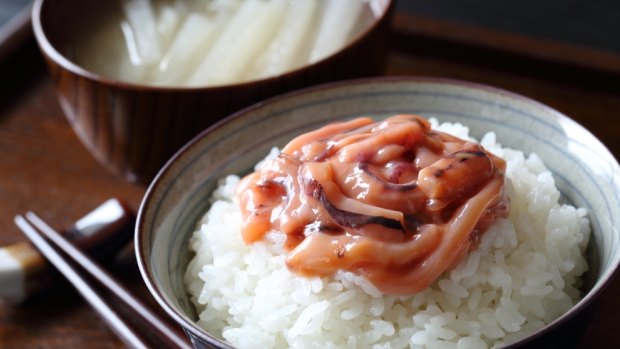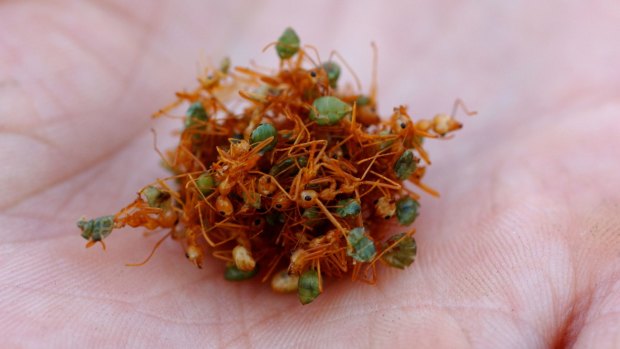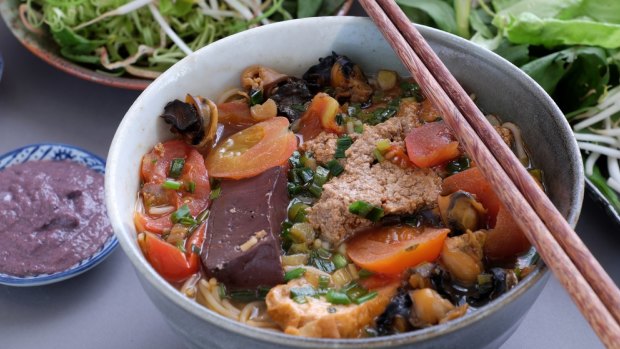This was published 5 years ago
Strange food from around the world: Ten unusual dishes you should try when you travel
By Ben Groundwater

Take a chance: you won't be disappointed.Credit: Shutterstock
There's nothing like that feeling of challenging yourself and winning, of taking a risk and having it succeed. That goes with so many things, and one of them is food.
You have to challenge yourself with food when you travel, you have to take chances on things you wouldn't normally even think of eating. This is what it's all about, experiencing the way other people do things, trusting that they know what they're doing, that the foodstuff that seems so strange to you is actually so delicious to everyone else.
It doesn't always work out. Sometimes the fermented horse milk in Mongolia that sounds so bad really is so bad. However, if you take a chance on the following dishes, you won't be disappointed.
Haggis, Scotland
Oddly enough, when you take all of the parts of a sheep that no one else wants – the heart, the liver and the lungs – mince it up and mix it with mutton fat, oatmeal and spices, then pack it in a sheep's stomach and boil it for a few hours, it tastes … really good. Like, properly good. Scotland isn't exactly known for its gastronomic prowess, but give me "haggis, neeps and tats" (haggis with turnips and potatoes) any day of the week.
Shiokara, Japan

Credit: Shutterstock
Most Japanese food is simple: it sounds delicious, and it is delicious. Pork cutlets with tangy slaw? Yes please. Char-grilled chicken with draught beer? You know it. But how about raw squid mixed with salty, fermented squid guts? This is shiokara, a Japanese staple, and one I used to hate. However, I'm slowly coming around. Once you get used to the slime, and fermented tang, and you wash your shiokara down with cold beer and good conversation, squid guts take on a whole new beauty.
Trippa alla Romana, Italy
Tripe, the stomach lining of a cow, is one of those "cucina povera", or peasant food, staples that is eaten by many of the world's great food cultures, and yet can still seem pretty challenging to those of us not used to it. In Rome, tripe is simmered low and slow in a rich, tomato-y sauce, and the result is an extremely tasty dish that every visitor to the Eternal City should sample.
Jellyfish, China
This is another of those staples in some countries that can appear challenging to those of us who only associate jellyfish with blue bottle stings and Irukandji scares. There's also a rubbery texture to jellyfish that some find a little challenging. However, the Chinese know what they're doing with these things. They mix jellyfish into salads, pair it with chicken, stir it through sesame oil … it's all tasty, and it's all low-fat.
Green ants, Australia

Credit: Alamy
You can keep your witchetty grubs, as far as I'm concerned: too squishy, too many guts. If I'm going bush tucker, it's definitely green ants, little insects that are pulled from trees, lightly crushed between your hands, and then devoured. They're lemony, peppery, and delicious. Locals producers are even putting them on top of goats cheeses now, with lemon myrtle, for extra zing. Seriously good.
Horse, Japan
I've had some less-than-ideal experiences with horse meat in the recent past (including death threats for saying I didn't like it), but an even more recent experience with this challenging protein has brought me around. On the southern island of Kyushu in Japan, they serve horse meat in an udon noodle soup, and it's really good: not too horsey, not too chewy, and subtly spiced. Perfect as a – ahem – mane meal.
Crickets, Thailand
You hear, occasionally, that insects are the protein source of the future, and to that I say: no problem. In northern Thailand, deep-fried crickets are a staple, and they're delicious. They're nutty and crunchy, perfect with a dousing of salt and a chaser of icy beer. I still struggle, however, with the larger insects. Anything that requires more than one bite, or contains the noticeable ooze of guts, is a bridge too far for this guy.
Warthog, East Africa
The main issue with eating warthog meat in countries such as Zimbabwe and Tanzania is a character called Pumbaa, the singing, dancing warthog in The Lion King. The association can be hard to break when you're presented with a grilled haunch of the guy who sang Hakuna Matata, but if you can get past that, warthog meat is really tasty, a gamier version of pork that you'll easily develop a taste for.
Snails, France
Escargot aren't exactly exotic – you'll find them on the menu at most French restaurants, even in Australia. However, some people are still squeamish about eating garden slugs, even though they needn't be. Fried up with plenty of garlic and butter, escargot are textural and moreish. Snails, in fact, are eaten in many countries, particularly Vietnam, where fried "oc", or sea snails, are a very tasty staple dish.
Bun rieu, Vietnam

Everything about bun rieu sounds good; well, almost everything. It's a crab-based soup mixed with vermicelli noodles. So far, so delicious. It's then topped with roasted tomatoes, crab meat, stewed pork, lime juice, chilli, fresh herbs, shredded banana flower and bean sprouts. Also extremely good. Then, however, you drop in a large hunk of congealed pig's blood, which is a serious challenge for the unsuspecting diner. My advice: give it a try. You won't regret it.
Which "weird" foods have you tried and enjoyed? Any you would never eat again?
Email: b.groundwater@fairfaxmedia.com.au
Instagram: instagram.com/bengroundwater
See also: The world's ten most divisive foods
See also: The ten dessert capitals of the world
Sign up for the Traveller Deals newsletter
Get exclusive travel deals delivered straight to your inbox. Sign up now.